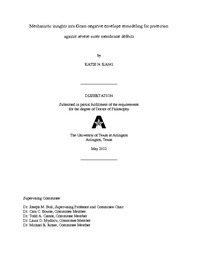
ATTENTION: The works hosted here are being migrated to a new repository that will consolidate resources, improve discoverability, and better show UTA's research impact on the global community. We will update authors as the migration progresses. Please see MavMatrix for more information.
Show simple item record
| dc.contributor.advisor | Boll, Joseph M | |
| dc.creator | Kang, Katie N | |
| dc.date.accessioned | 2022-06-28T15:12:21Z | |
| dc.date.available | 2022-06-28T15:12:21Z | |
| dc.date.created | 2022-05 | |
| dc.date.issued | 2022-05-23 | |
| dc.date.submitted | May 2022 | |
| dc.identifier.uri | http://hdl.handle.net/10106/30407 | |
| dc.description.abstract | Gram-negative bacteria account for the majority of antibiotic resistant infections. Regulated modifications within the cell envelope can promote resistance to clinically important antibiotics. The increased prevalence of antibiotic treatment failure highlights the importance of investigating the underlying resistance mechanisms. Of particular concern is resistance to last-line antimicrobials, such as polymyxin E (colistin). Colistin is a cationic antimicrobial lipopeptide that binds the negatively charged lipid A domain of lipopolysaccharide, a glycolipid enriched in the Gram-negative outer membrane, to perturb the envelope and lyse the cell. However, several Gram- negative pathogens have evolved intrinsic colistin resistance mechanisms. For example, many Enterobacteriaceae modify their LPS with amine-containing moieties to prevent colistin binding. Enterobacter cloacae (Ecl) exhibits colistin heteroresistance, where a subpopulation is resistant to the antibiotic. Here, we demonstrate that colistin heteroresistance in E. cloacae is facilitated by 4- amino-4-deoxy-L-arabinose (L-Ara4N) addition to lipid A via regulation by the PhoPQ two- component system. Prior to this study, there was not detailed understanding of heteroresistance mechanisms in Ecl. While several pathogens modify lipid A to prevent colistin binding, only Acinetobacter baumannii (Ab) is known to mutationally inactivate lipid A biosynthesis to develop colistin resistance. Notably, LOS was considered essential for viability in Gram-negatives; however, the mechanism that enables Ab to survive without LOS (LOS-) is unknown. We found that two LD-transpeptidases, LdtJ and LdtK, were essential for LOS- survival in Ab. Furthermore, we characterized their biochemical activities and showed they are important for mechanical stability during cell envelope stress. Lastly, we found that the PG synthase PBP1A in Ab is necessary for productive division in Ab. PBP1A and is required for rapid growth, which may be detrimental for LOS- cells to assemble an outer membrane. | |
| dc.format.mimetype | application/pdf | |
| dc.language.iso | en_US | |
| dc.subject | Antibiotic resistance | |
| dc.subject | LOS | |
| dc.subject | Acinetobacter baumannii | |
| dc.subject | Pbp1a | |
| dc.subject | ldtK | |
| dc.subject | ldtJ | |
| dc.title | Mechanistic insights into Gram-negative envelope remodeling for protection against severe outer membrane defects | |
| dc.type | Thesis | |
| dc.degree.department | Biology | |
| dc.degree.name | Doctor of Philosophy in Quantative Biology | |
| dc.date.updated | 2022-06-28T15:12:21Z | |
| thesis.degree.department | Biology | |
| thesis.degree.grantor | The University of Texas at Arlington | |
| thesis.degree.level | Doctoral | |
| thesis.degree.name | Doctor of Philosophy in Quantative Biology | |
| dc.type.material | text | |
| dc.creator.orcid | 0000-0003-3026-5360 | |
Files in this item
- Name:
- KANG-DISSERTATION-2022.pdf
- Size:
- 22.65Mb
- Format:
- PDF
This item appears in the following Collection(s)
Show simple item record


